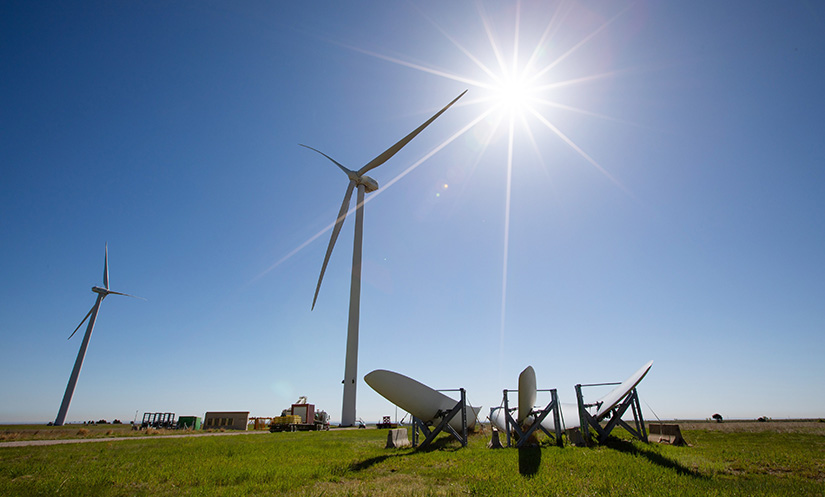NREL Researchers Point to Path for Improved Wind Blade Recycling Rates

Researchers at the National Renewable Energy Laboratory (NREL) are considering circular economy strategies to mitigate the impact of wind turbine blades at the end of their useful lifespan.
The strategies are meant to address what to do with the blades once they are no longer needed, including using new materials that are easier to break down, extending their lifespan, and implementing various recycling options. Researchers at NREL have been investigating novel blade materials that are inherently more recyclable, thereby integrating solutions at the earliest stages of turbine component design.
“We want to see everything recycled, ideally,” said Aubryn Cooperman, an engineering analyst at NREL and coauthor of a new paper outlining the steps that need to be taken.
Realistically, however, as wind turbines reach the end of their useful, expected 20-year lifespan, some of the massive blades are bound to be discarded. More than 90% of wind energy facilities in the United States began generating power within the last decade. An estimated 10,000 to 20,000 blades annually are expected to be at the end of their lifespan between 2025 and 2040.
Owners of wind power plants will be increasingly faced with decisions about what to do with these blades, the researchers noted in a new paper, “Regional Representation of Wind Stakeholders’ End-of-Life Behaviors and Their Impact on Wind Blade Circularity.” In addition to Cooperman, the iScience article was coauthored by NREL researchers Julien Walzberg, Liam Watts, Annika Eberle, Alberta Carpenter, and Garvin Heath.
The scientists relied on a computer model that considers behavioral factors, which can undermine the viability of technical solutions. For example, a lack of trust in a new technology may keep it from reaching its full market potential. Therefore, the researchers point out, it is considered critical to understand the behavioral aspects of wind power industry stakeholders’ decisions. Those stakeholders run the gamut from operators of wind sites to companies in the recycling business. The modeling tool, developed by researchers at NREL and publicly available, is the Circular Economy Wind Agent-Based Model.
The researchers said that in the absence of policy change or recycling technology development, as much as 78% of decommissioned blades are expected to end up in landfills, though that still would be a relatively small percentage of the amount of discarded waste at an estimated 1% nationwide in 2050. Among the factors hindering recycling are high transportation costs and subjective norms, which discourage people from recycling the blades if they see others not already doing so. By encouraging enough early adopters, recycling blades would become the norm.
“Transportation costs are a huge factor, because the blades themselves are huge,” said Walzberg, the paper’s lead author. “If your recycling facility is far away, that's going to make it a barrier for you to try to recycle.”
Lowering those transportation costs could make a significant difference in how the old blades are disposed of. The blades are typically made of steel, plastic, and composite materials. While many of the materials now commonly used for the blades are easily broken down, they can be shredded with the right equipment.
“Shredding the blades makes them smaller and easier to ship to a recycling facility,” Walzberg said. “That's kind of a low-hanging fruit. But you need to be able to shred the blades before transportation.”
Even reducing the cost of shredding blades by a third before transportation could decrease the cumulative landfill rate below 50%, the scientists calculated in the new study. Another scenario that involves boosting early adoption of recycling so that it becomes the norm could bring the figure below 10%.
Walzberg said regulations could help boost recycling numbers as well and pointed to laws enacted to keep lead-acid batteries from landfills and old rubber tires from being burned.
The researchers said future work could study how increasing the number of recycling facilities for wind turbine blades could change the results. Meanwhile, other NREL scientists are already working on using new materials for blades that are intended to improve their recyclability.
The journal article builds on research published last year by Cooperman, working alongside Eberle and another NREL colleague, Eric Lantz. That article revealed “more profound shifts in recycling technologies, blade materials, or policy may be needed to move towards a circular economy for wind turbine blades.”
Funding for the research came from the U.S. Department of Energy’s Advanced Manufacturing Office and the Office of Strategic Programs.
Learn more about NREL’s analysis efforts and research into wind energy and advanced manufacturing.
Last Updated May 28, 2025
